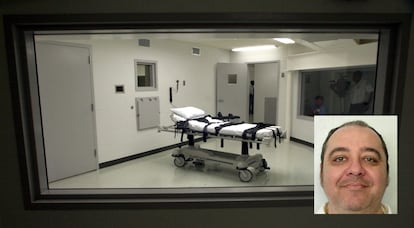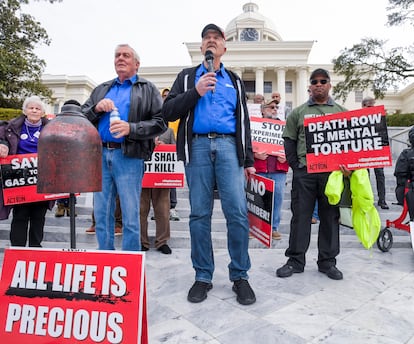Alabama uses experimental nitrogen gas method to kill death row inmate it already tried to execute in 2022
Kenneth Eugene Smith was found guilty of murdering a woman in the 1980s and had survived another attempt at execution by lethal injection in which the vein could not be found


The second time around, Alabama achieved its goal of killing Kenneth Eugene Smith. Governor Kay Ivey, a Republican, confirmed that the state had executed the inmate with an experimental method: nitrogen asphyxiation. Smith, who was pronounced dead at 8:25 p.m., had been sentenced to death for the contract killing of a preacher’s wife in the late 1980s.
It was a trial run, and it was successful within minutes. The southern state tested the nitrogen hypoxia technique, criticized as “inhumane” by anti-death penalty activists and the United Nations, on a prisoner who had already been sent to the execution chamber to receive a lethal injection in 2022. However, executioners were unable to find the right vein in time before the death warrant expired; after being tied to a gurney for four hours, he was sent back to his cell.
Witnesses to the execution described “two to four minutes of convulsions” and “five minutes of heavy breathing,” and said that Smith gave a final statement: “Tonight, Alabama caused humanity to take a step backward. I’m leaving with love, peace and light. Thank you for supporting me, love all of you.” When the gas started to flow, he looked at his wife and added: “I love you.”
The governor’s office released a statement that said: “After more than 30 years and attempt after attempt to game the system, Mr. Smith has answered for his horrendous crimes.” Before the execution, the state had claimed that nitrogen hypoxia is “the most painless and humane method of execution known to man.”
On Thursday, shortly before 7 p.m., the Supreme Court reaffirmed a ruling from the previous day denying the stay of execution. Witnesses, including five journalists who were allowed to attend the execution, the condemned man’s lawyers, Smith’s wife and the children of both the murderer and the victim, boarded a van bound for the Holman Correctional Facility in Atmore to witness the execution. Prison workers strapped a commercial industrial-safety respirator mask to his face, and left the room. Smith was left alone with his spiritual adviser, the Reverend Jeff Hood.
Smith spent his final moments saying goodbye to his wife and family members and ordering a last lunch: steak, hashbrowns and eggs, topped with gravy, ordered from the Waffle House fast food chain. Meanwhile, his lawyers asked the Supreme Court to stop the execution in extremis. The defense’s argument was based on doubts about the process, despite the fact that it was Smith himself who had opted for hypoxia when he was given the choice after the failure of the previous attempt with lethal injection. In a concern shared by doctors, anti-capital punishment activists and the office of the UN High Commissioner for Human Rights, there were fears that death would be slow and painful, that inhalation of the gas would cause vomiting and the prisoner would drown, that the gas would not do its job and the prisoner would be left in a vegetative state, or that there would be a deadly gas leak endangering the life of Reverend Hood.

“Mr. Smith was selected for execution even though he has not been able to fully exhaust claims raised in a separate proceeding arising from that failed attempt, which is a deviation from the State’s custom, and treats Mr. Smith differently than other similarly situated inmates,” the filing said. “And the State is proceeding ahead despite the mounting evidence of Mr. Smith’s escalating post-traumatic stress disorder (PTSD) symptoms, which create a substantial risk that he will vomit during the execution and asphyxiate, causing prolonged or superadded pain and suffering.”
“Grasping at straws”
The Alabama attorney general’s office disdained those aspirations, saying Smith was “grasping at straws.” “The district court found (twice over) that Smith’s fear was ‘speculative,’ ‘theoretical,’ and ‘unlikely,’” the response said. And the 11th Circuit agreed ‘there is no evidence that Smith is likely to vomit at the moment in which nitrogen is introduced into the mask.’”
The protocol approved by Alabama promised that after the introduction of nitrogen gas [into the inmate’s body], it will be administered for 15 minutes or for five minutes after the EKG shows a flat line. Whichever comes first.
Smith, 58, was convicted of participating in the 1989 contract killing of Elizabeth Sennett, along with another man named John Forrest Parker. The pair stabbed her and beat her to death with a fireplace poker in exchange for a $1,000 payment promised to each of them by the victim’s husband, an adulterous preacher who later called the police and tried to pass off the plot as a violent raid on the family home. When he found himself cornered, he committed suicide. Alabama killed Parker with a lethal injection in June 2010. A third person involved in the murder, Billy Gray Williams, was sentenced to life in prison without the possibility of parole and died behind bars in 2020.
The use of nitrogen hypoxia is due to the difficulties encountered in recent years with lethal injection, a method that was introduced in 1982 in Texas and has been used to kill 1,377 convicts in the last 42 years.
The search for alternatives has intensified in recent times, in view of the fact that pharmaceutical companies have been refusing, as a matter of corporate image, to sell these drugs to the States, whose stocks have already expired. Moreover, in 2011, the European Union banned the export of these drugs to the United States. This is one of the reasons why only five states carried out the death penalty in 2023. Smith was the third prisoner in a row to be sent to die in Alabama only to be returned to his cell when the vein could not be found.
Sign up for our weekly newsletter to get more English-language news coverage from EL PAÍS USA Edition
Tu suscripción se está usando en otro dispositivo
¿Quieres añadir otro usuario a tu suscripción?
Si continúas leyendo en este dispositivo, no se podrá leer en el otro.
FlechaTu suscripción se está usando en otro dispositivo y solo puedes acceder a EL PAÍS desde un dispositivo a la vez.
Si quieres compartir tu cuenta, cambia tu suscripción a la modalidad Premium, así podrás añadir otro usuario. Cada uno accederá con su propia cuenta de email, lo que os permitirá personalizar vuestra experiencia en EL PAÍS.
¿Tienes una suscripción de empresa? Accede aquí para contratar más cuentas.
En el caso de no saber quién está usando tu cuenta, te recomendamos cambiar tu contraseña aquí.
Si decides continuar compartiendo tu cuenta, este mensaje se mostrará en tu dispositivo y en el de la otra persona que está usando tu cuenta de forma indefinida, afectando a tu experiencia de lectura. Puedes consultar aquí los términos y condiciones de la suscripción digital.
More information
Archived In
Últimas noticias
ICE raids trigger school absenteeism and traumatize children: ‘They have been forced to leave their childhood behind’
The guardians of the meteorites of the Argentine Chaco
Helen Levitt, the photographer who captured the theater of the everyday
The life of a delivery driver in China: ‘Many people don’t know how an order can arrive at their home in just one day’
Most viewed
- Christian Louboutin: ‘Young people don’t want to be like their parents. And if their parents wear sneakers, they’re going to look for something else’
- US sanctions against jailed cartel leader ‘El Marro’ highlight Mexico’s lack of control over its prisons
- The low-cost creative revolution: How technology is making art accessible to everyone
- Liset Menéndez de la Prida, neuroscientist: ‘It’s not normal to constantly seek pleasure; it’s important to be bored, to be calm’
- Cartels in Mexico take a leap forward with narco-drones: ‘It is criminal groups that are leading the innovation race’










































